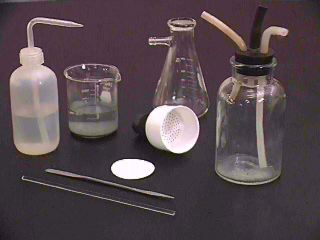
IMAGE 1. Common equipment needed for a
vacuum filtration.
|
The side-arm receiving flask should be much larger than the amount of liquid that it will ultimately contain. Add the volume of the mixture and the volume of any rinses or washes together to approximate the total volume that the flask will have to contain. Then, select a side-arm flask that is much larger than this total volume (if the approximation is 100 mL, select a 250 mL flask).
Inspect the side-arm flask for defects. The flask should be free of chips or cracks that could cause the flask to implode when the interior pressure is reduced (a vacuum is initiated).
A Buchner funnel or fritted-glass crucible should be small enough that the surface of the filter is completely covered, but large enough to contain all of the solid as a thin layer.
Paper and fritted-glass are available with different separation properties called the filter grade. Coarse, medium, and fine grades are typically available. Coarse grades will separate relatively large particles from the liquid. Fine grades will separate all but the smallest particles from the liquid, and medium grades will perform somewhere in between. The finer the grade, the more time it will take for the filtration. Thus, you should select the coarsest grade that will completely separate the solid from the liquid (this selection comes with experience).
Note: If the filtrate contains solid after the filtration, check for leaks or channels in the filter. Barring a leak or channel, select a finer grade of paper or fritted glass for the next experiment.
|